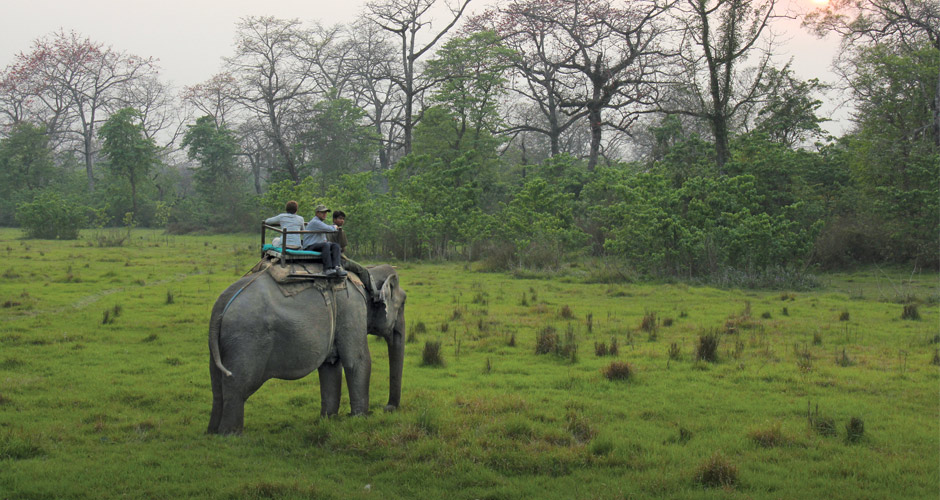I cautiously step into muddy water and wade towards an enormous wrinkly mammal. She is kneeling down on her knees and elbows, and the naturalist tells me to climb onto her back. I splash her with water and scratch her big floppy ears, before stepping up onto her hind legs and lunging my body over hers, scrambling with all my limbs to climb up onto her back. Respectfully, she does not shower me with water from her bulging trunk, but gently sprays her sides to wash herself while I pat her head and stroke her back. A bathing experience with Sonar Kali the elephant was just one of a collection of magical moments from a visit to the Tiger Tops Tharu Lodge at Nepal’s Chitwan National Park.
I am to discover that the Tiger Tops jungle experience is more than just a rare sighting of the famous Bengal tiger. Instead, an abundance of wildlife and local village people charm their way into my heart and mind. A 30-minute flight south from Kathmandu to Bharatpur and a 60-minute car trip from the airport to the lodge transform my surrounds from a bustling and dusty cityscape to the lush jungle village of the Tharu people. The Tharu are an ethnic group indigenous to the Terai region at the southern foothills of the Himalayas, and have a distinct peacefulness to their culture.
The lodge emulates the longhouse style of Tharu architecture, its straw-bale structure nestled amidst the forest adjacent to the buffer zone of the Chitwan National Park. From the moment I arrive, the staff brings the jungle experience alive. The naturalists are always on-hand to plan jungle activities, all of which have one goal – to capture the essence of jungle life. Activities include an early morning or late-afternoon elephant safari, an ox-and-cart ride through the national park or a long-boat journey down the Rapti River. There are also options to trek on foot through the national park, visit the lodge-sponsored local school, and gain insights into Nepalese village life and the daily routines of the elephants. And if that isn’t enough, at each mealtime I am presented with the local harvest, immaculately prepared into an amazing feast. Lunchtime is my favourite, sitting outside under the mango trees listening to gentle breezes push through the leaves amidst the chirping sounds of the jungle, whilst indulging in local Nepalese curries and homemade papadum. My belly goes wild in anticipation of this daily ritual.
My first elephant safari starts off as what could be described as … awkward. I step onto the elephant from the platform and sit facing out, with the master perched on the elephant’s head and my naturalist standing on its rear. From the first step the elephant takes, my body jolts with each bounding stride from her two-tonne body. After about an hour of this movement, I get into her rhythm, as if I am dancing with her, moving in tune to her movements. It feels amazing. After a face-off with a feasting rhinoceros in the forest thicket, we cross back over the creek that marked the commencement of the safari. I look back on our tracks and there sitting, waiting to be noticed, is a leopard. A glimpse of a Bengal tiger is high on my wishlist, but the naturalist’s excitement at our find proves this to be an even rarer discovery. The unique specimen is one of only about 35 in the entire 932-sq km expanse of the national park (as opposed to the 120 Bengal tigers).
Elephant safari through the national park is one experience, but trekking through the park on foot requires a totally different mindset. Chitwan is one of only a few parks in the world that can be explored on foot, and the fresh Bengal tiger footprint that I spot in the sand upon entering the park speaks volumes as to why. Along the trek I find myself sneaking past a protective mother rhino whilst her baby feeds beside her, and my mind is propelled into overdrive about what to do in the case of a rhino stampede. I recall the naturalist’s instructions: Climb a tree. If you can’t climb one, hide behind one. If there is no tree, gather together with other people in a group, with your stick, and make as much noise as you can. And if all else fails, run in zigzags. My heart is pounding! Jungle escape plan aside, we pass quietly without disturbing mother or baby.
Further along the trek, chattering monkeys swing effortlessly from tree to tree and crocodiles lie beside the path, rolling in the mud. Male peacocks dance in a splash of colour, wild boar snort and oversized deer are in full force as they become aware of another presence, quickly racing across the path and crashing into the underbrush. Far off in the distance, I hear the trumpeting sound of the locally feared wild elephant, which sends chills down my spine. The abundance of wildlife I’ve seen and heard on the trek is amazing, but it’s those I haven’t seen that are firmly imprinted on my imagination, flashing across my mind at every crunch of a leaf or crack of a twig and sending my heart racing.
Visit tigertops.com for further information.

